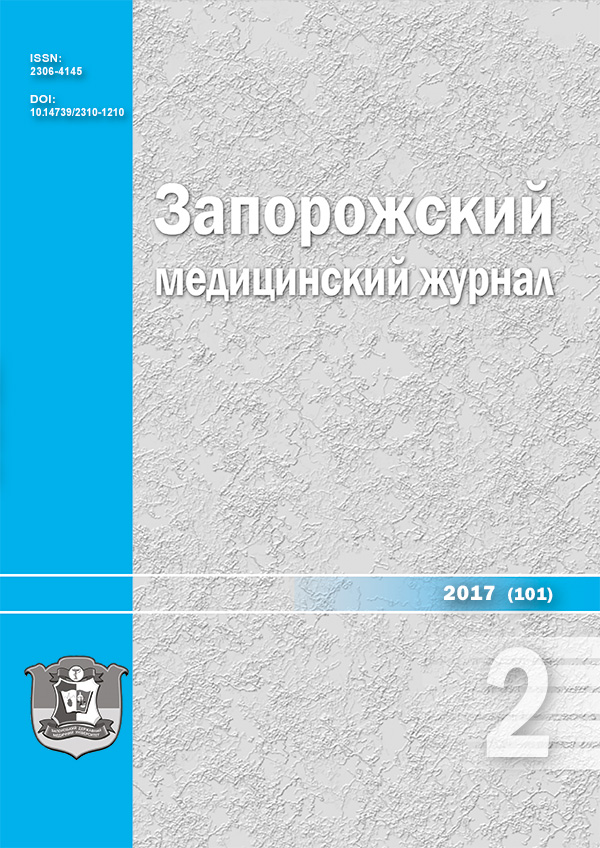Characteristics of the opportunistic infections in patients with HIV-infection 3-4 stage
DOI:
https://doi.org/10.14739/2310-1210.2017.2.95743Keywords:
HIV, opportunistic infections, cryptococcosis, рneumocystis pneumonia, histoplasmosisAbstract
Objective: To analyze the main opportunistic infections group characteristic in patients with HIV-infection 3–4 stage.
The article is dedicated to the basic characteristics of the related diseases that occur in the later stages of HIV infection. Ways of origin, clinical symptoms, severity and complications were discussed. According to UNAIDS not HIV-infection but associated diseases one of the leading causes of death in these patients. In the next decade, as before, these diseases will play a significant role in global average premature mortality. As it is known, a feature of HIV is to lead to the development of the opportunistic infections and multiple organ lesions on a background of progressive immunodeficiency. As a result, doctors of all specialties increasingly have to deal with various diseases of organs and systems, which can develop in patients with HIV infection.
Therapy, which is intended for patients with HIV infection, is usually different. Interaction of drugs and their toxicity, high risk of serious side effects should be noted. This problem can be solved by improving prescribing schemes taking into account the features of the disease in each case specifically.
Conclusions: Opportunistic infections in HIV-infected – a unique group of diseases that develop on the background of immunodeficiency state and differ significantly from other infectious diseases. The uniqueness lies in the peculiarities of clinical manifestations and requirements of the prescribed therapy. Opportunistic infections are the major cause of lesions and lethal effects in patients with HIV infection. From early diagnosis of co-infection treatment depends on the success and longevity of patients, as well as preventive measures. Tendency to multiple organ and systemic lesions require differential diagnosis with modern research techniques, including specific immunological and serological methods.
References
(2009). VIL-infektsiia v Ukraini. Inf. biuleten №31. [HIV infection in Ukraine. Inf. Bulletin number 31]. Kyiv [in Ukrainian].
(2016). VIL-infektsiia v Ukraini. Inf. biuleten №46 [HIV infection in Ukraine. Inf. Bulletin number 46]. Kyiv [in Ukrainian].
Melenko, S. R., Moskaliuk, V. D., & Lesiuk, Yu. M. (2010). Perebih kriohlobulinemii pry antyretrovirusnii terapii VIL – infektsii [The course cryoglobulinemia with antiretroviral therapy HIV – infection]. Visnyk naukovykh doslidzhen, 3, 31–35 [in Ukrainian].
Melenko, S. R., & Moskaliuk, V. D. (2008). VIL-infektsiia / SNID – problemy i perspektyvy [HIV – infection. AIDS - problems and prospects]. Infektsiini khvoroby, 2, 98–100. [in Ukrainian].
Klimko, N. N. (2007). Mikozy: diagnostika, lechenie: rukovodstvo dlya vrachej [Mycosis: Diagnosis, Treatment: guidance for doctors]. Moscow [in Russian].
Vasil`eva, N. V. (2002). Kriptokokki y kriptokokkoz na sovremennom e´tape [Cryptococcus and cryptococcosis at the present stage]. Problemy medicinskoj mikologii, 4(2), 45–46. [in Russian].
Lesovoy, V. S., & Lipnitsky, A. V. (2008). Mikozy centralʹnoj nervnoj siystemy (obzor) [Mycoses of central nervous system (review)]. Problemy medicinskoj mikologii, 10(1), 3–7. [in Russian].
Dillingham, R., Lima, A., & Guerrant, R. L. (2004) Guerrant Cryptosporidiosis: epidemiology and impact. Microbes and Infection, 4, 1059–1066.
Fayer, R., Xiao, L., & Raton, B. (2007). Cryptosporidium and Cryptosporidiosis. New York: CRC Press.
Chen, X. M. (2002). Cryptosporidiosis. N. Engl. J. Med., 346(22), 1723–1731.
Samie, A., Bessong, P. O., Obi, C. L., Sevilleja, J. E., Stroup, S., Houpt, E., & Guerrant, R. L. (2006) Cryptosporidium species: preliminary descriptions of the prevalence and genotype distribution among school children and hospital patients in the Vendaregion, Limpopo Province, South Africa. Exp. Parasitol, 114, 314–322. doi: 10.1016/j.exppara.2006.04.007.
Houpt, E. R., Bushen, O. Y., Sam, N. E., Kohli, A., Asgharpour, A., Ng, C. T., et al. (2005). Asymptomatic Cryptosporidium hominis infection among human immunodeficiency virus-infected patients in Tanzania. Am. J. Trop. Med. Hyg, 73, 520–522.
Tavazzi, E., Ferrante, P., & Khalili, K. (2011). Progressive multifocal leukoencephalopathy: an unexpected complication of modern therapeutic monoclonal antibody therapies. Clin Microbiol Infect, 17(12), 1776–1780. doi: 10.1111/j.1469-0691.2011.03653.x.
Moskaliuk, V. D., & Melenko, S. R. (2012). VIL-infektsiia/SNID [HIV. AIDS]. Chernivtsi: Vydavnytstovo Bukovynskoho derzhavnoho medychnoho universytetu [in Ukrainian].
Orsi, A. T., Nogueira, L., Chrusciak-Talhari, A., Santos, M., Ferreira, L. C., Talhari, S., & Talhari, C. (2011) Histoplasmosis and AIDS co-infection. An Bras Dermatol, 86(5), 1025–1026.
Melenko, S. R. (2010). Virusni Ko-infektsii u khvorykh na VIL-infektsiiu [Viral Co – infections in patients with hiv-infection]. Bukovynskyi medychnyi visnyk, 14, 2(54), 63–65. [in Ukrainian].
Choronvil, A. V., & Hrytsko, R. Yu. (2010). Infektsiini khvoroby [Infection diseases]. Kyiv: Medytsyna [in Ukrainian].
Holubovska, O. A. (Ed.) (2012). Infektsiini khvoroby [Infection diseases]. Kyiv. Kyiv: Medytsyna [in Ukrainian].
Ministerstvo okhorony zdorovia Ukrainy (2004) Klinichnyi protokol likuvannia oportunistychnykh infektsii u khvorykh na VIL-infektsiiu/SNID [Clinical protocol for treatment of opportunistic infections in patients with HIV – infection. AIDS]. Kyiv. [in Ukrainian].
Javed, F. (2004). Pneumocystis carinii Infection. Archives of Pathology & Laboratory Medicine, 128(9), 1023–1027.
Downloads
How to Cite
Issue
Section
License
Authors who publish with this journal agree to the following terms:
- Authors retain copyright and grant the journal right of first publication with the work simultaneously licensed under a Creative Commons Attribution License that allows others to share the work with an acknowledgement of the work's authorship and initial publication in this journal.

- Authors are able to enter into separate, additional contractual arrangements for the non-exclusive distribution of the journal's published version of the work (e.g., post it to an institutional repository or publish it in a book), with an acknowledgement of its initial publication in this journal.
- Authors are permitted and encouraged to post their work online (e.g., in institutional repositories or on their website) prior to and during the submission process, as it can lead to productive exchanges, as well as earlier and greater citation of published work (See The Effect of Open Access)





